
Introduction to Australia
Australia is a country, and continent, surrounded by the Indian and Pacific oceans. Its major cities – Sydney, Brisbane, Melbourne, Perth, Adelaide – are coastal, but its capital, Canberra, is inland and nicknamed the “Bush Capital.” The country is known for its Sydney Opera House, Great Barrier Reef, the vast Outback (interior desert wilderness) and unique animal species including kangaroos and duck-billed platypuses.
Climate
Australia’s landmass of 7,617,930 square kilometres (2,941,300 sq mi)[130] is on the Indo-Australian Plate. Surrounded by the Indian and Pacific oceans,[N 5] it is separated from Asia by the Arafura and Timor seas, with the Coral Sea lying off the Queensland coast, and the Tasman Sea lying between Australia and New Zealand. The world’s smallest continent[132] and sixth largest country by total area,[133] Australia—owing to its size and isolation—is often dubbed the “island continent”,[134] and is sometimes considered the world’s largest island.[135] Australia has 34,218 kilometres (21,262 mi) of coastline (excluding all offshore islands),[136] and claims an extensive Exclusive Economic Zone of 8,148,250 square kilometres (3,146,060 sq mi). This exclusive economic zone does not include the Australian Antarctic Territory.[137] Apart from Macquarie Island, Australia lies between latitudes 9° and 44°S, and longitudes 112° and 154°E.
The Great Barrier Reef, the world’s largest coral reef,[138] lies a short distance off the north-east coast and extends for over 2,000 kilometres (1,240 mi). Mount Augustus, claimed to be the world’s largest monolith,[139] is located in Western Australia. At 2,228 metres (7,310 ft), Mount Kosciuszko on the Great Dividing Range is the highest mountain on the Australian mainland. Even taller are Mawson Peak (at 2,745 metres or 9,006 feet), on the remote Australian territory of Heard Island, and, in the Australian Antarctic Territory, Mount McClintock and Mount Menzies, at 3,492 metres (11,457 ft) and 3,355 metres (11,007 ft) respectively.[140]
Advantages of Study in Australia
Australia is both a country and a continent and is closest to Indonesia, East Timor, Papua New Guinea, Vanuatu, New Caledonia, New Zealand and the Solomon Islands. It is located in the Indian and Pacific Oceans and is considered by some to be the “world’s largest island.”
Study Abroad in Australia
People living in Australia generally speak English but add to it a wonderful accent and distinct vernacular. Indigenous languages, of which there are close to seventy, are still spoken but quickly disappearing. If preserving indigenous languages is of interest to you, studying abroad in Australia might be a wonderful opportunity to help save native languages.
The currency in Australia is the dollar but not the green one. Be sure to trade your green dollars for colorful Australian ones once you’ve arrived. Australia makes most of its money through an open-market economy that operates much like that in the United States. Its economy is broad and diverse but distinguishes itself by utilizing an abundance of natural resources and being one of the world’s largest exporters of wine. If you’ve ever had an interest in tending to vineyards, turning grapes into wine, bottling products or selling an in-demand product, Australia might be the perfect place for you. Be sure to contact the Australian consulate or embassy prior to your visit if you want to live, study, and work in Australia; you’ll need to secure a passport, study visa and work visa.
If studying history, promoting peace and serving justice are elements of interest to you in your studies; an Australia study abroad program might be the perfect fit for you. The country’s political and social dynamics will add to the intrigue of your visit, and if you aren’t fluent in a foreign language, this could be a great study abroad destination for you to explore.
Education in Australia
Education in Australia is primarily the responsibility of the states and territories. Each state or territory government provides funding and regulates the public and private schools within its governing area. The federal government helps fund the public universities, but was not involved in setting university curriculum.[8] As of 2012, the Australian National Curriculum,[9] under development and trial for several years, has already been adopted by some schools and will become mandatory soon. Generally, education in Australia follows the three-tier model which includes primary education (primary schools), followed by secondary education (secondary schools/high schools) and tertiary education (Universities, TAFE colleges and Vocation Education and Training providers/VET providers).
Australian Universities & Colleges
- Australian College of Physical Education (ACPE)
- Australian Institute of Applied Sciences (AIAS)
- Australian National University College
- Cambridge International College
- Charles Darwin University ATMC
- Charles Sturt University Study Centres
- Federation University ATMC
- Flinders International Study Centre
- Holmes Institute
- Martin
- Pacific College of Technology
- Raffles College
- Southern Cross University
- Strathfield College
- Taylors College
- The University of Sydney Foundation Program
- The University of Western Australia Foundation Program
Process:
a. Select Course
b. Select Institute
c. Apply for Admission through GIEC Study Abroad
d. Pay University Fee
e. Process for Visa
f. Receive Visa Decision